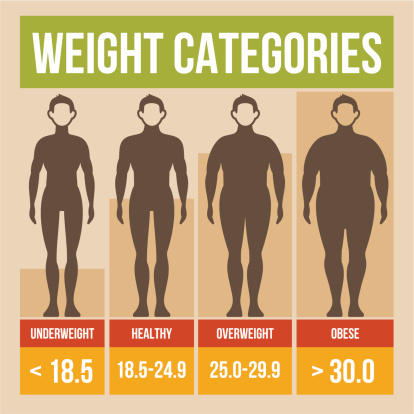
What is the Body Mass Index (BMI)?
Body Mass Index (BMI) is a number calculated from a person’s weight and height. BMI is a fairly reliable indicator of body fatness for most people. BMI does not measure body fat directly, but research has shown that BMI correlates to direct measures of body fat, such as underwater weighing and dual-energy x-ray absorptiometry (DXA).1, 2 BMI can be considered an alternative for direct measures of body fat. Additionally, BMI is an inexpensive and easy-to-perform method of screening for weight categories that may lead to health problems.
How is BMI used?
BMI is used as a screening tool to identify possible weight problems in adults. However, BMI is not a diagnostic tool. For example, a person may have a high BMI. However, to determine if excess weight is a health risk, a healthcare provider would need to perform further assessments. These assessments might include skinfold thickness measurements, evaluations of diet, physical activity, family history, and other appropriate health screenings.
Why is BMI used to measure overweight and obesity?
Calculating BMI is one of the best methods for population assessment of overweight and obesity. Because calculation requires only height and weight, it is inexpensive and easy to use for clinicians and for the general public. The use of BMI allows people to compare their own weight status to that of the general population.
What are some of the other ways to measure obesity?
Other methods to measure body fatness include skinfold thickness measurements (with calipers), underwater weighing, bioelectrical impedance, dual-energy x-ray absorptiometry (DXA), and isotope dilution. However, these methods are not always readily available, and they are either expensive or need highly trained personnel. Furthermore, many of these methods can be difficult to standardize across observers or machines, complicating comparisons across studies and time periods.
What are the health consequences of being overweight and obese for adults?
The BMI ranges are based on the relationship between body weight and disease and death.5 Overweight and obese individuals are at increased risk for many diseases and health conditions, including the following:
- Hypertension
- Dyslipidemia (for example, high LDL cholesterol, low HDL cholesterol, or high levels of triglycerides)
- Type 2 diabetes
- Coronary heart disease
- Stroke
- Gallbladder disease
- Osteoarthritis
- Sleep apnea and respiratory problems
- Some cancers (endometrial, breast, and colon)
Find Your BMI Results Now:
BMI For Adults Widget
Information provided by cdc.gov
